Staking and mining are two popular methods of generating cryptocurrency. Staking is another technique to generate money with cryptocurrency. Staking allows you to put your digital assets to work and earn passive revenue without selling them. Staking is identical to putting money in a high-yield savings account in specific ways. Banks lend out your deposits, and you receive interest on the sum in your account.
Since the debut of Bitcoin in 2009, the world of cryptocurrencies has come a long way. There are thousands of cryptocurrencies available today, each with its own unique set of features and applications. One way to profit from cryptocurrencies is to sell your investment when the market price rises. The other one considers a unique mining and tokenization alternative staking.
Let’s look at the differences between cryptocurrency staking and mining and help you decide which is best for you.
What is Cryptocurrency Mining?
Cryptocurrency mining is the process of verifying transactions and creating new blocks on a blockchain network by solving complex mathematical equations. When a miner successfully creates a new block, they earn a reward in the form of a new cryptocurrency. The amount of cryptocurrency earned depends on the difficulty of the equations and the network’s reward structure. Mining is typically done on a Proof of Work (PoW) network. PoW is a consensus algorithm that requires miners to solve complex equations using computational power. The first miner to solve the equation and validate the block is rewarded.
What is Crypto Staking
The process of storing coins in a wallet to support the network’s security and operations is known as crypto staking. When you stake your Bitcoin, you help validate transactions and keep the network running, and you are rewarded for it. The payout amount is determined by the cryptocurrency you are staking as well as the network’s staking requirements.
Staking is commonly performed on a Proof of Stake (PoS) network. PoS is a consensus mechanism that allows participants to validate transactions and produce new blocks based on the number of coins they have in their possession. The more coins you stake, the more rewards you can win.
Participants wishing to validate new transactions offer to stake quantities of Bitcoin as a type of insurance. They may lose some or all of their stake if they inappropriately validate defective or fraudulent data. However, if they verify the right, legitimate transactions and data, they will be rewarded with extra cryptocurrency. Staking is used as part of the consensus mechanisms of popular cryptocurrencies Solana (SOL) and Ethereum (ETH).
Proof of Stake Validation
Proof of stake coins foster flourishing ecosystems on their networks by staking. Generally, the higher the stake, the better the opportunity validators have to add new blocks and earn rewards.
As validators collect more stake delegations from numerous holders, this serves as proof to the network that the validator’s consensus votes are reliable, and their votes are thus weighted proportionally to the amount of stake the validator has garnered.
Also, a stake does not have to be made up of just one person’s tokens. A holder, for example, can join a staking pool, and stake pool managers can handle all of the heavy labor involved in verifying transactions on the blockchain.
Each blockchain has a distinct set of verification rules. Ethereum, for example, requires each validator to have at least 32 ETH. That’s around $38,965 at the time of writing. A staking pool allows you to pool your resources and stake less than the maximum amount. However, it should be noted that these pools are often constructed using third-party technologies.
How does Staking work?
You can stake your tokens if you hold a cryptocurrency that employs a proof of stake blockchain. Staking secures your funds to join and contribute to the security of the network’s blockchain. Validators receive staking incentives in that cryptocurrency in exchange for locking up their assets and participating in network validation.
For example, staking is implemented with up to 50% APY on BetFury, an ecosystem of crypto products, and passive income is provided daily. You must have 100 BFG (BetFury native utility tokens) to collect incentives. BFG tokens and five prominent coins (USDT, ETH, BTC, BNB, and TRX) are accepted for withdrawal. When you select BFG, your payouts increase as you invest more BetFury tokens. Cryptocurrencies like BFG can be traded on popular exchanges and won by playing on the platform.
You can also create a Bitcoin wallet that allows for staking. You may choose how much of your portfolio you wish to put up for staking if you have your tokens in one of these wallets. To find a validator, you choose from various staking pools. They pool your tokens with those of others to increase your chances of generating blocks and getting rewards.
What’s the difference between Saking and Mining?
Everyone is probably aware of Bitcoin mining, which is the process of creating new blockchain blocks in exchange for a reward. The biggest issue with mining is excessive power consumption and the requirement for expensive equipment that handles complex computations.
While both staking and mining can result in Bitcoin rewards, there are a few significant distinctions between the two.
Network Security
Staking and mining both help secure networks, but in different ways. Staking includes storing cryptocurrency in a wallet to assist in validating transactions and keeping the network secure. Mining, on the other hand, necessitates the use of computer power to solve complex equations and validate transactions. As a result, mining consumes more energy than staking.
Technical Requirements and Equipment
Staking needs little equipment and technical knowledge. You only need a Bitcoin wallet and some coins to bet. Mining, on the other hand, necessitates the use of specialized hardware and software, as well as technical skills to set up and maintain the equipment.
Structure of Reward
Staking and mining have different reward structures. Staking rewards are often a fixed percentage of the coin being staked, and they are distributed over time. On the other hand, mining incentives are often paid in the form of a new cryptocurrency, with the quantity gained based on the complexity of the equations and the network’s reward structure.
The Benefits and Drawbacks of Staking
Staking, like other ways to earn money in the crypto world, has advantages and disadvantages. Let’s gather and point out the most crucial details to consider.
Benefits of Staking
- High passive income potential.
- Unlike mining, energy efficiency can be achieved without the use of specialized equipment.
- Traditional trading carries less risk.
- There are no operational or maintenance costs.
- Stakers play an important role in the cryptocurrency initiative.
- Investors can access their investments quickly and easily.
- It can be used in transactions all over the world.
Drawbacks of Staking
- The price of cryptocurrencies and the quantity of rewards vary.
- Possible periods of Bitcoin blocking (lock-up).
- You must split your earnings and pay fees.
Wrap Up
To summarize, both crypto staking and mining have advantages as well as drawbacks. Mining offers larger earnings and more investment potential, while staking is more accessible and ecologically friendly. Staking is a one-of-a-kind passive income system that has become a gateway into the crypto world for many enthusiasts. The decision between staking and mining comes down to your investing objectives, risk tolerance, and available funds.


